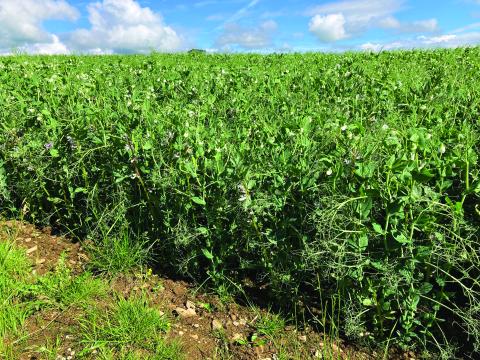Last year, Pembrokeshire farmer, Eurig Jones, harvested 20 acres (8ha) of peas and beans he’d grown as part of a Farming Connect trial. The mixed crop was calculated, through the Welsh Government/EU-sponsored project, to have cost him just Åí117 per tonne to produce.
However, the crop produced a high-quality concentrate feed with an analysis of 26.6% crude protein, a metabolisable energy (ME) of 13.6MJ/kg DM and a D-value of 93.4%. If he’d used contractors, rather than his own labour and machinery, it would have cost him £223 per tonne to produce.
The pea/bean mix was preserved as crimp using a Korte 1400 crimper and the preservative, CrimpSafe 300, applied at the time of harvest. It was stored and sealed in a clamp, ready to use in winter rations.
The haulm from the crop produced high-quality straw which was chopped and baled, and treated with the preservative, BaleSafe, to ensure it would store without spoilage. Analysis of the straw was ME 7.5MJ/kg DM and 8.0 crude protein (see Table 1) and it was used instead of barley straw in cattle total mixed rations.
Farming beef, sheep and arable, with his father, Wyn, across 1,100 acres at Pantyderi Farm in Boncath, Mr Jones says that today, the pea/bean mix forms part of both the grower and finisher rations they feed to some 400 head of cattle which pass through the farm each year. This has allowed them to completely ditch the 36% protein, maize distillers and rapeseed blend they formerly used. The cost of this blend at the time of the trial was £280 per tonne but has increased in price to around £420 per tonne today.
He says: “We feel lucky we became involved with this project when we did as it’s an important step towards our goal of becoming self-sufficient in protein in the beef enterprise.”
Dr Delana Davies from Farming Connect, who managed the project, said: “The process of crimping is perfect for livestock farmers, many of whom do not have dry feed storage.
“By crimping the crop, all they need is a small clamp, which can even be outside, which you can find or create on most livestock farms,” she says. “Bagging the feed in tubes is another option, which can be carried out by a contractor.”
However, she says the high nutritional analysis will prove to be the real attraction of the crimped pea/bean mix.
“Both the high protein and energy highlight what a tremendous feed it is, plus the protein quality in terms of limiting amino acids is superior to barley and silage,” she says.
Cost of the ration
Independent nutritionist, Hefin Richards, used the legume mix to formulate grower and finisher rations equal in energy and protein to the previous year. The daily ration costs were £1.29 and £2.18 per head for the growing and finishing ration. This compared with £1.35 and £2.39 per head the previous year and resulted in a saving of £5,588 per 200 head of growing and finishing cattle on Pantyderi
Farm (see Table 2). All ration costs assumed the crimped legume mix was made by contractors but would have been substantially less if the farm’s own costings (own labour and equipment) had been used.
Livestock performance
As well as achieving a saving in cost, the rations have lifted daily liveweight gain. This was predicted for the grower ration to increase to 1.19kg/head compared to 1.15kg in 2020. In the finishing diet, predicted gains increased to 1.44kg/head/day compared with 1.43kg/ head/day in 2020.
The reality reported this winter on the Jones family farm is somewhat better.
As Mr Jones says: “We’ve been really pleased to see growth rates of close to 1.5kg/day in weaned calves and the older groups.”
Mr Richards says that not only are the home-grown legumes cheaper, but farmers who grow them are not exposed to the volatility of the protein feed market.
“Margins in beef are very tight so if you are growing rather than buying in, your costs are far more controlled,” he says. “While the cost of buying a tonne of feed may increase from, say £170 to £350 in the space of under a year, the costs associated with growing will change far less, especially if you’re not buying fertiliser.”
No fertiliser used
In fact, no artificial fertiliser was applied to the pea and bean crop at Pantyderi, and the only further treatments it received before harvest were the pre-emergence herbicide at drilling and two spray applications for chocolate spot.
Other benefits include the lack of a need for haulage of purchased feeds as diesel prices rise, and equally, the avoidance of soya in the diet which is not permitted under the terms of some contracts.
Furthermore, the nitrogen left in the soil by the legumes has given tangible benefits to the following crop of wheat.
Dr Davies explains: “We have nitrate sensors in the field and we found that nitrogen was not required for the following crop of winter wheat until April.”
This was thanks to residual nitrogen from the nitrogen-fixing nodules on the roots of the legume, estimated at approximately 100kg per hectare.
An industry first
“We believe this is the first time peas and beans have been bi-cropped in this way,” she added. “Although the Processors and Growers Research Organisation [PGRO] has carried out promising plot trials, nothing similar has been done on a field scale before.”
She says: “Growing the crop has proven to be successful on so many fronts. It has reduced the purchased fertiliser and feed requirements for the farm and reduced the carbon footprint of the beef enterprise, so improving sustainability credentials.”
Mr Jones himself says he’s increased his acreage to 30 this year and hopes to grow more in 2023.
Mr Richards concludes: “The aim at Pantyderi was to increase self-sufficiency, maintain performance and reduce costs, and all of those boxes have been ticked.”
How, why and with what success was the pea and bean crop grown at Pantyderi Farm?
• Single crops of beans or lupins had been considered for Pantyderi Farm, but bi-cropping beans
and peas and crimping them was considered to have a greater yield potential. The storage of
crimp was also considered to be suited to typical livestock farm facilities.
• The growth habits of beans and peas are very complementary – the peas provide earlier and
better ground cover which helps smother weeds while the beans provide a scaffold to help the
peas stand later in the season.
• The two crops also benefit from the same agronomy approach.
• Choosing to crimp gives flexibility to the timing of harvest, through a degree of tolerance to
uneven ripening. The aim was to harvest at 30-35% moisture to meet the requirements for
crimping as well as the combine harvesting.
• Growing the crops together tends to synchronise any varietal differences in time to maturity.
• A further benefit of the two crops was the different sizes of the pea and bean, with the peas filling
gaps between the larger beans in the clamp. This minimised air pockets and facilitated the
attainment of anaerobic conditions to achieve a quick and stable fermentation.
• Lime was applied to the trial field at a variable rate of 937kg/ha to lift the pH from 5.8 to the ideal
for beans of pH6.5.
• Farmyard manure was applied at 25t/ha; there was no requirement for artificial nitrogen.
• The seed was planted in two passes on 22 April; the beans were sown first at a rate of 308kg/ha
and a depth of 60mm, followed by the peas at 225kg/ha and a depth of 30mm.
• Seed rates were calculated using an app available through the Processors and Growers Research
Organisation (PGRO).
• A pre-emergence herbicide was used and a fungicide was applied to tackle chocolate spot.
• The crop yielded 5.25t/ha - 42 tonnes from 20 acres (8ha) – and also produced nine bales per
acre (22 bales/ha) of haulm, which is nutritionally superior to straw.
• The crop was harvested on 3 September using the farm’s own combine, fitted with a side knife.
• Apart from having to clean out the combine sieves on the first day when the crop was slightly
damper around the headland, the crop was combined easily.
• A local crimping contractor processed the crop, applying four litres per tonne of CrimpSafe 300
diluted 50:50 with water and the clamp was rolled and sealed.
Farming Connect is delivered by Menter a Busnes and Lantra Wales and funded by the Welsh
Government and the European Agricultural Fund for Rural Development.
Access the article as it originally appeared in Kelvin Cave's KnowHow Newsletter in summer 2022 below.



